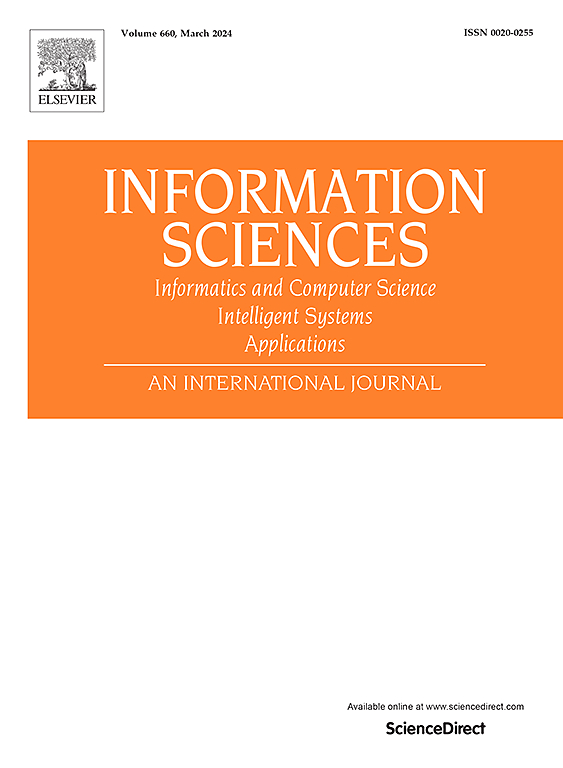A cognitive dual-attention network with feature specificity for automated CRC polyp detection
IF 6.8
1区 计算机科学
0 COMPUTER SCIENCE, INFORMATION SYSTEMS
引用次数: 0
Abstract
Colorectal cancer is the foremost cause of cancer-related deaths worldwide. Thus, early diagnosis of precancerous polyps is crucial for more effective treatment outcomes. To address the persistent issues in colorectal cancer diagnosis, this study proposes a novel classification model, E-D2AN (Efficiently Dilated Dual Attention Network), capable of accurately distinguishing colorectal abnormalities from normal colonoscopy images. The proposed model features dual attention mechanisms of EDCAM (Efficiently Dilated Channel Attention Mechanism) and ESAM (Efficient Spatial Attention Mechanism) strategies, utilizing an extended ResNet50 as the backbone. This network prioritizes efficient attention mechanisms, enriching feature extraction through an expanded receptive field and significantly driving attention-focused learning to achieve improved precision in the classification model. This combination improves the model’s ability to locate and focus on crucial regions in images, resulting in higher diagnostic precision. Dropblock regularization is also used strategically to reduce overfitting and improve generalization to unseen images. The proposed E-D2AN model excels across all three benchmark datasets, demonstrating superior performance over existing approaches. Prominently, it achieves an accuracy of 83.69 % on PolypsSet, 99.74 % on CKC, and 98.75 % on Kvasir-2 datasets. These findings reveal the model’s ability to improve the accuracy and reliability of early polyp detection.
一种具有特征特异性的认知双注意网络用于CRC息肉自动检测
结直肠癌是全球癌症相关死亡的首要原因。因此,癌前息肉的早期诊断对于更有效的治疗结果至关重要。为了解决结直肠癌诊断中持续存在的问题,本研究提出了一种新的分类模型,E-D2AN(高效扩张双注意网络),能够准确区分结直肠癌异常和正常结肠镜图像。该模型采用扩展的ResNet50作为主干,具有EDCAM (Efficient Dilated Channel attention Mechanism)和ESAM (Efficient Spatial attention Mechanism)双重注意机制。该网络优先考虑有效的注意机制,通过扩展的接受域丰富特征提取,并显著推动以注意为中心的学习,以提高分类模型的精度。这种组合提高了模型定位和聚焦图像中关键区域的能力,从而提高了诊断精度。Dropblock正则化也用于减少过拟合和提高对未见图像的泛化。所提出的E-D2AN模型在所有三个基准数据集上都表现出色,表现出比现有方法更优越的性能。值得注意的是,它在PolypsSet上达到了83.69%的准确率,在CKC上达到了99.74%,在Kvasir-2数据集上达到了98.75%。这些发现表明该模型能够提高早期息肉检测的准确性和可靠性。
本文章由计算机程序翻译,如有差异,请以英文原文为准。
求助全文
约1分钟内获得全文
求助全文
来源期刊

Information Sciences
工程技术-计算机:信息系统
CiteScore
14.00
自引率
17.30%
发文量
1322
审稿时长
10.4 months
期刊介绍:
Informatics and Computer Science Intelligent Systems Applications is an esteemed international journal that focuses on publishing original and creative research findings in the field of information sciences. We also feature a limited number of timely tutorial and surveying contributions.
Our journal aims to cater to a diverse audience, including researchers, developers, managers, strategic planners, graduate students, and anyone interested in staying up-to-date with cutting-edge research in information science, knowledge engineering, and intelligent systems. While readers are expected to share a common interest in information science, they come from varying backgrounds such as engineering, mathematics, statistics, physics, computer science, cell biology, molecular biology, management science, cognitive science, neurobiology, behavioral sciences, and biochemistry.
 求助内容:
求助内容: 应助结果提醒方式:
应助结果提醒方式:


